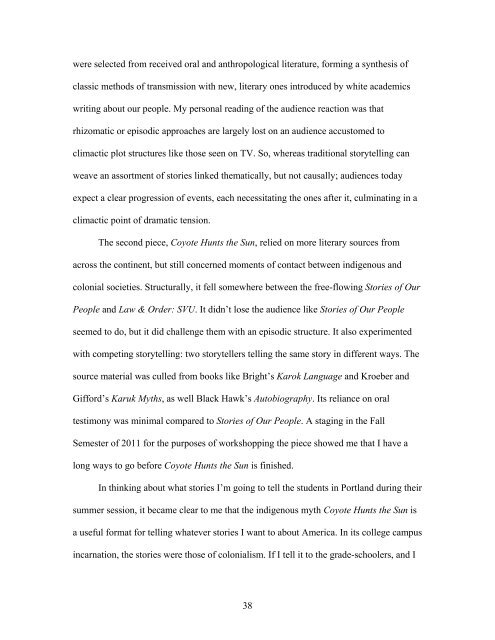The Intersection of Karuk Storytelling and Education
The Intersection of Karuk Storytelling and Education
The Intersection of Karuk Storytelling and Education
You also want an ePaper? Increase the reach of your titles
YUMPU automatically turns print PDFs into web optimized ePapers that Google loves.
were selected from received oral <strong>and</strong> anthropological literature, forming a synthesis <strong>of</strong><br />
classic methods <strong>of</strong> transmission with new, literary ones introduced by white academics<br />
writing about our people. My personal reading <strong>of</strong> the audience reaction was that<br />
rhizomatic or episodic approaches are largely lost on an audience accustomed to<br />
climactic plot structures like those seen on TV. So, whereas traditional storytelling can<br />
weave an assortment <strong>of</strong> stories linked thematically, but not causally; audiences today<br />
expect a clear progression <strong>of</strong> events, each necessitating the ones after it, culminating in a<br />
climactic point <strong>of</strong> dramatic tension.<br />
<strong>The</strong> second piece, Coyote Hunts the Sun, relied on more literary sources from<br />
across the continent, but still concerned moments <strong>of</strong> contact between indigenous <strong>and</strong><br />
colonial societies. Structurally, it fell somewhere between the free-flowing Stories <strong>of</strong> Our<br />
People <strong>and</strong> Law & Order: SVU. It didn’t lose the audience like Stories <strong>of</strong> Our People<br />
seemed to do, but it did challenge them with an episodic structure. It also experimented<br />
with competing storytelling: two storytellers telling the same story in different ways. <strong>The</strong><br />
source material was culled from books like Bright’s Karok Language <strong>and</strong> Kroeber <strong>and</strong><br />
Gifford’s <strong>Karuk</strong> Myths, as well Black Hawk’s Autobiography. Its reliance on oral<br />
testimony was minimal compared to Stories <strong>of</strong> Our People. A staging in the Fall<br />
Semester <strong>of</strong> 2011 for the purposes <strong>of</strong> workshopping the piece showed me that I have a<br />
long ways to go before Coyote Hunts the Sun is finished.<br />
In thinking about what stories I’m going to tell the students in Portl<strong>and</strong> during their<br />
summer session, it became clear to me that the indigenous myth Coyote Hunts the Sun is<br />
a useful format for telling whatever stories I want to about America. In its college campus<br />
incarnation, the stories were those <strong>of</strong> colonialism. If I tell it to the grade-schoolers, <strong>and</strong> I<br />
38
















